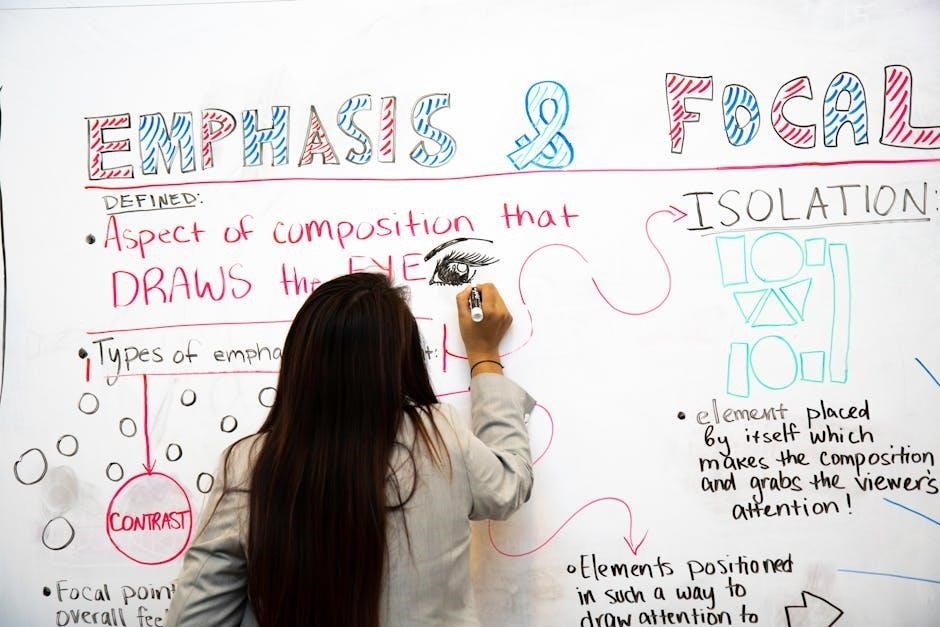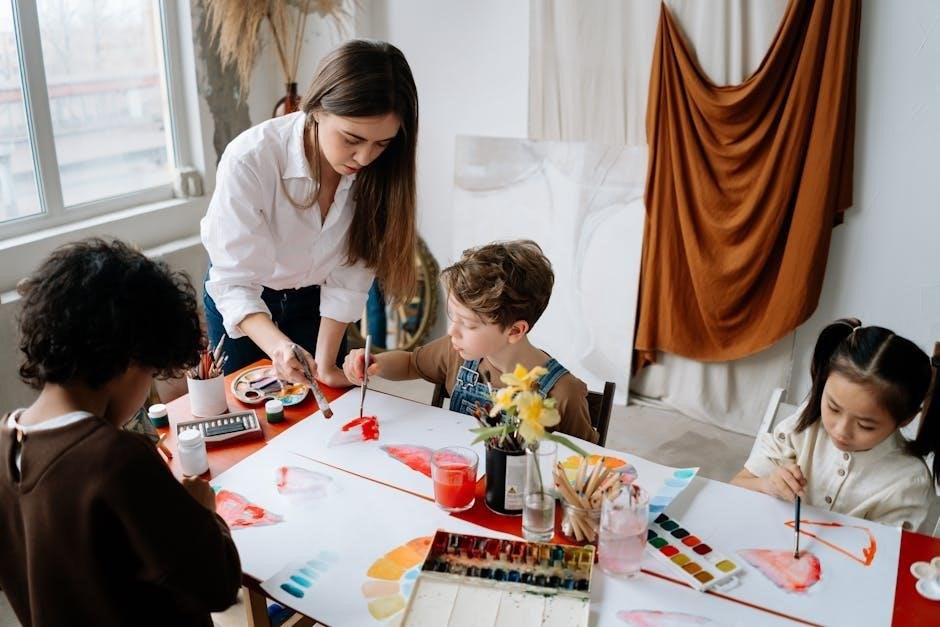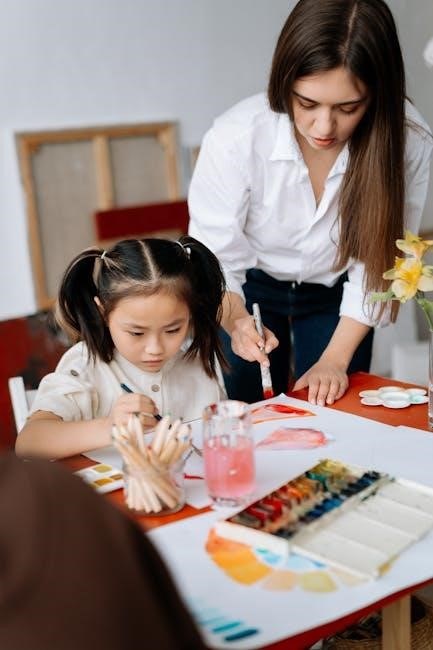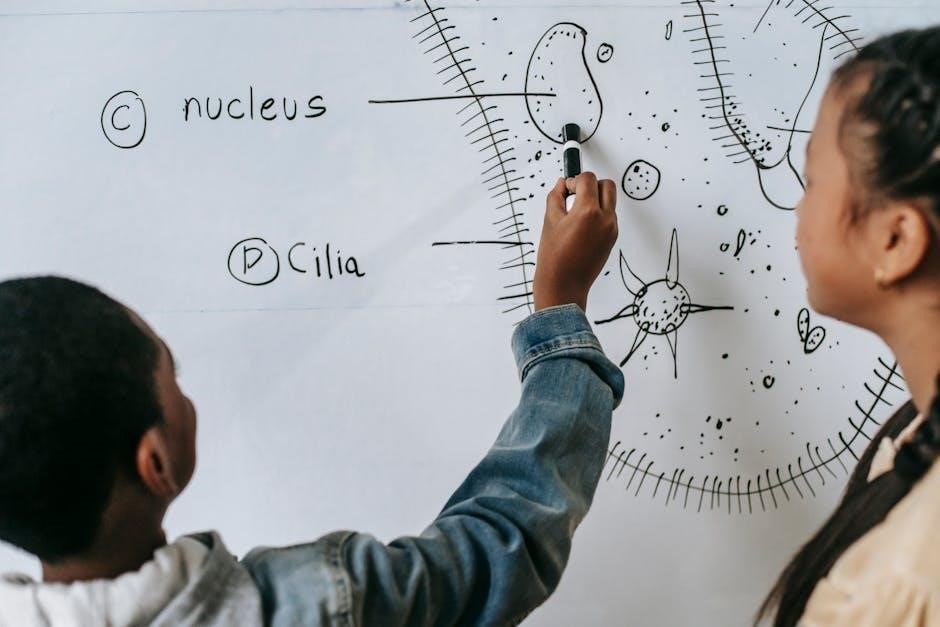Instruction drawing simplifies the learning process through step-by-step guides, making it accessible for all skill levels․ It emphasizes clear directions and a safe, nurturing environment to build confidence and skills in drawing․
1․1 Definition and Purpose of Instruction Drawing
Instruction drawing is an educational tool that provides clear, step-by-step visual guidance for learning to draw․ Its purpose is to simplify complex techniques, making them accessible to all skill levels․ By breaking down processes into manageable steps, it helps build confidence and understanding․ Instruction drawing is particularly useful for beginners, offering structured lessons that ensure steady progress․ It fosters creativity while teaching foundational skills, creating a supportive environment for artistic growth․
1․2 Importance of Step-by-Step Guides in Learning
Step-by-step guides are essential for making complex drawing tasks manageable․ They provide clear directions, reducing intimidation and fostering confidence․ This structured approach allows learners to progress at their own pace, ensuring steady improvement․ By breaking down processes into simpler steps, guides enhance creativity and understanding․ They are particularly effective for kids and beginners, offering a foundational framework that builds skills gradually․ Step-by-step guides ensure a smooth learning experience, making drawing accessible and enjoyable for all skill levels․

Materials and Tools Required for Instruction Drawing
Pencils, erasers, sketchbooks, and sharpeners are essential tools for instruction drawing․ Quality paper and a comfortable workspace also play a crucial role in the learning process․
2․1 Essential Drawing Tools for Beginners
For beginners, essential tools include graphite pencils (HB, 2B, 4B), erasers, a sharpener, and a sketchbook․ A ruler and blending stumps are optional but helpful for details and shading․ These basics provide a solid foundation for learning to draw effectively and confidently․
2․2 Recommended Paper and Surfaces for Drawing

For instruction drawing, choose high-quality paper with a smooth finish, such as cartridge paper or Bristol board․ Mixed-media paper is versatile for both dry and wet techniques․ Ensure the surface is clean and flat to avoid distortion․ Proper paper selection enhances precision and control, making the learning process more enjoyable and effective for beginners and experienced artists alike․
Basic Drawing Techniques
Mastering basic techniques like perspective, proportion, and shading forms the foundation of instruction drawing․ These skills help create realistic and balanced artwork, enhancing learning effectiveness․
3․1 Understanding Perspective and Proportion
Understanding perspective and proportion is crucial for creating realistic drawings․ Perspective involves depicting depth on a flat surface, while proportion ensures subjects are accurately sized․ These techniques, taught through step-by-step guides, help artists achieve balance and realism, making instruction drawing effective for learners of all levels․ By mastering these fundamentals, beginners can build a solid foundation for more complex artistic endeavors․
3․2 Mastering Basic Shapes and Lines
Mastering basic shapes and lines is the cornerstone of instruction drawing․ By starting with simple forms like circles, squares, and triangles, learners can break down complex subjects into manageable parts․ Lines, including straight, curved, and diagonal, form the basis of all drawings․ These foundational elements, taught through easy exercises, help build hand-eye coordination and confidence․ Practicing these basics regularly ensures a strong artistic foundation, making it easier to tackle more intricate designs and subjects in the future․
Shading and texture are essential techniques in instruction drawing that add depth and realism to artwork․ Shading involves creating tonal variations using hatching, cross-hatching, or stippling․ These methods enhance dimension and form․ Texture, on the other hand, adds surface detail, making objects appear more lifelike․ By practicing these techniques, learners can create engaging and detailed drawings․ Regular exercises and feedback help refine these skills, leading to more polished and professional artwork․
Step-by-Step Drawing Guides
Step-by-step guides provide clear, structured lessons for drawing various subjects, from animals to cartoon characters․ They simplify complex techniques, making learning fun and accessible for all skill levels․

4․1 How to Draw Animals: A Beginner’s Guide
Learn to draw animals with simple, step-by-step instructions․ Start by sketching basic shapes like circles, ovals, and lines to form the body structure․ Pay attention to proportion and perspective, ensuring features like eyes and legs are correctly placed․ Add details such as fur texture, feather patterns, or scales for realism․ Practice drawing facial expressions to capture the animal’s personality․ Begin with simple subjects like cats or dogs, then progress to more complex creatures․ Regular practice and patience will help refine your skills and bring your animal drawings to life․
4․2 Drawing Plants and Flowers: Simple Techniques
Start by sketching basic shapes like circles or ovals for flower heads․ Add petals using gentle curves, varying sizes for depth․ For leaves, use teardrop shapes with pointed tips․ Experiment with textures like veins on leaves or pollen details․ Practice drawing stems and branches with smooth lines․ Simplify complex flowers like roses by breaking them into smaller parts․ Adapt techniques for different plants, from delicate orchids to robust sunflowers․ Pay attention to natural arrangements to create balanced compositions․ Regular practice will enhance your ability to capture the beauty of plants and flowers․
4․3 Cartoon Character Drawing for Fun
Cartoon character drawing is a delightful way to express creativity․ Start with basic shapes like circles or squares for heads, then add exaggerated features․ Use bold lines for outlines and soft curves for details․ Experiment with playful expressions and poses to bring characters to life․ Simplify complex forms by breaking them into manageable parts․ Incorporate fun accessories like hats or props for personality․ Practice drawing popular characters or create your own unique designs․ Regular practice and creativity will help you master the art of cartoon character drawing with ease and enjoyment․

Facial Features and Portrait Drawing
Mastering facial features and portrait drawing involves understanding proportions, expressions, and detail․ Start with basic shapes, then refine features like eyes, noses, and mouths for realism․ Practice capturing emotions and individuality․ Step-by-step guides help beginners achieve accuracy and confidence in their portraits․ Regular practice enhances your ability to draw lifelike faces and expressions, fostering creativity and precision in your artwork․
5․1 Drawing the Human Face: Proportions and Expressions
Drawing the human face requires understanding proportions and expressions․ Start by dividing the face into thirds for accurate placement of features․ Practice capturing emotions through subtle changes in facial muscles․ Use step-by-step guides to refine details like eyes, eyebrows, and mouth shapes․ Pay attention to symmetry and alignment to achieve realistic results․ Regular practice helps master expressions, from subtle smiles to complex emotions․ Combining these techniques enhances your ability to create lifelike portraits․ Begin with basic shapes and gradually add details for a polished finish․
5․2 Step-by-Step Guide to Portrait Drawing
Begin by sketching the outline of the face, ensuring proper proportions․ Divide the face into thirds for accurate feature placement․ Start with the eyes, nose, and mouth, using light lines․ Refine details like eyebrows and lip shapes․ Shade gently to create depth and dimension․ Practice capturing expressions by adjusting facial muscles․ Use reference images for accuracy․ Regular practice enhances your ability to portray realistic features․ Combine these steps to create detailed, expressive portraits․ Start simple and gradually add complexity for polished results․
Drawing Exercises and Warm-Up Activities
Engage in hand-eye coordination exercises to refine motor skills․ Practice simple shapes and lines for foundational mastery․ Regular practice fosters improvement and artistic confidence․
6․1 Hand-Eye Coordination Practices
Enhance your drawing skills with exercises that improve hand-eye coordination․ Practice tracing shapes, drawing lines, and sketching patterns to refine motor control․ These activities strengthen accuracy and dexterity, essential for precise drawing․ Regular practice helps develop consistency and confidence in your artistic abilities․ Start with simple exercises like tracing circles or squares, then gradually move to more complex patterns․ Over time, these drills will enhance your ability to translate visual ideas onto paper with precision and clarity․
6․2 Simple Drawing Exercises for Beginners
Beginners can start with simple exercises like sketching basic shapes, lines, and patterns․ Practice drawing circles, squares, and triangles to build foundational skills․ Gradually incorporate shading techniques to add depth to your work․ Exercises like contour drawing and gesture sketching also help improve observation and accuracy․ These activities are designed to be fun and engaging, making the learning process enjoyable while developing essential drawing techniques․ Regular practice will lead to steady progress and increased confidence in your artistic abilities․

Drawing for Kids and Young Learners
Engage young learners with fun, easy drawing activities designed for kids, such as drawing cupcakes and other enjoyable subjects to foster creativity and skill development․

7․1 Fun and Easy Drawing Lessons for Children

Engage young learners with simple, step-by-step drawing lessons designed to spark creativity․ Start with basic shapes and light lines, gradually building complexity․ Use fun subjects like cupcakes, animals, and plants to keep children excited․ These lessons are perfect for developing fine motor skills and fostering self-expression․ Encourage practice and patience, allowing kids to explore their artistic side․ Make drawing a joyful experience that builds confidence and a lifelong love for art․
7․2 How to Draw Cupcakes and Other Fun Subjects
Teach children to draw cupcakes and other fun treats with simple, step-by-step guides․ Start with basic shapes like circles for the base and frosting․ Add details like sprinkles or candles using dots and lines․ Encourage creativity by experimenting with colors and decorations․ Extend this to other fun subjects like ice cream cones or candy․ These exercises foster fine motor skills, creativity, and confidence while making learning enjoyable and engaging for young artists․
Advanced Drawing Techniques
Explore advanced methods like perspective, shading, and texture to enhance depth and realism in your artwork, building on foundational skills for more complex and detailed creations․
8․1 Perspective Drawing: Advanced Concepts
Advanced perspective drawing involves mastering complex techniques like multiple vanishing points, horizon lines, and atmospheric perspective․ These methods create depth and realism in compositions, allowing artists to craft immersive scenes․ Understanding how to layer elements and manipulate scale enhances the illusion of space․ Practicing these techniques helps refine spatial reasoning and visual storytelling․ Online tutorials and guides provide step-by-step lessons to explore these concepts deeply, ensuring artists can apply them effectively in their work․
8․2 Detailed Shading and Texture Techniques
Detailed shading and texture techniques enhance depth and realism in drawings․ Shading involves creating gradients and shadows to define form, while texture mimics surface qualities․ Advanced methods include hatching, cross-hatching, stippling, and contour shading․ These techniques require precision and patience․ Tools like graphite pencils, blending stumps, and erasers are essential․ Practice exercises, such as shading spheres or fabric textures, refine skills․ Online tutorials offer guides to master these elements, helping artists achieve intricate, lifelike details in their work․
Drawing Tutorials for Specific Subjects
Focus on specific subjects like sharks, marine life, cupcakes, and facial features․ Step-by-step guides and resources make learning fun and accessible for all skill levels․
9․1 How to Draw Sharks and Marine Life
Learn to draw sharks and marine life with easy step-by-step tutorials․ Start with basic shapes, then add fins, tails, and details․ Use shading to create depth and texture․ Capture the movement and grace of marine creatures․ Follow guides for proportional accuracy and realistic features․ Practice drawing different species, from simple fish to complex ocean animals․ Resources and playlists offer visual aids and expert tips for beginners․ Make learning fun and engaging with clear instructions and creative projects․
9․2 Drawing Facial Features: Eyes, Nose, and Mouth
Mastering facial features starts with proportional accuracy․ Begin with the eyes, ensuring proper spacing and alignment․ Use simple shapes for the iris and pupil, adding details like lashes․ The nose is next, focusing on its contour and subtle shading․ Finally, sketch the mouth, defining its curve and expression․ Step-by-step guides and video tutorials provide expert tips for realistic results․ Practice shading to add depth and emotion, enhancing your ability to capture lifelike expressions in your portraits․
Assembly Instruction Drawings in AutoCAD
Learn to create detailed assembly drawings in AutoCAD with expert tutorials․ Downloadable resources guide you through precise drafting and annotation for technical accuracy and clarity․
10․1 Tutorial on Creating Assembly Drawings
This tutorial guides users through creating precise assembly drawings in AutoCAD․ It covers setting up templates, inserting components, and adding annotations․ Learn to use tools like constraints and dimensions for technical accuracy․ The tutorial emphasizes organizing parts logically and ensuring clarity in assembly instructions․ Step-by-step instructions help beginners master the basics, while advanced users can refine their skills․ Downloadable resources, such as sample files, are provided to practice and reinforce learning․ This tutorial is ideal for engineering and manufacturing applications, ensuring detailed and professional results․
10․2 Downloadable Resources for AutoCAD Tutorials
Enhance your AutoCAD skills with downloadable resources, including sample files, templates, and practice exercises․ These tools provide hands-on experience, helping you master assembly drawing techniques․ Resources are designed for both beginners and advanced users, offering step-by-step guides and project files․ Downloadable content includes detailed tutorials, video lessons, and printable guides․ These resources ensure you can practice and refine your skills offline, making learning flexible and accessible․ They are ideal for students, professionals, and hobbyists seeking to improve their technical drawing abilities․
Learning Resources and Guides
Explore online resources, including tutorials, courses, and downloadable guides, designed to enhance your drawing skills through structured learning and practical exercises․
11․1 Free PDF Guides for Drawing
Free PDF guides offer comprehensive lessons for learners of all levels․ They often include step-by-step instructions, covering basics like perspective, shading, and proportions; Many guides are tailored for beginners, providing easy-to-follow exercises to build confidence․ These resources are ideal for self-paced learning, allowing users to practice at their own convenience․ Some guides also include advanced techniques for those looking to refine their skills․ They are a valuable tool for anyone seeking structured instruction without the cost of traditional courses․
11․2 Recommended Books for Learning to Draw
Recommended books for learning to draw provide structured, comprehensive guides tailored for all skill levels․ Many focus on step-by-step instruction, breaking down complex techniques into manageable lessons․ These books often cover essential topics like shading, perspective, and proportion, offering practical exercises to enhance skills․ Whether for beginners or intermediate learners, they provide a systematic approach to mastering drawing․ Some popular titles include “How to Draw Cool Stuff” and “The New Drawing on the Right Side of the Brain,” which cater to diverse learning styles and artistic goals․

Online Tutorials and Playlists
Online tutorials and playlists offer accessible, step-by-step guides for learning to draw․ Platforms feature diverse topics, from basic exercises to advanced techniques, catering to all skill levels․
12․1 Easy Drawing Exercises and Projects
Easy drawing exercises and projects are designed to help beginners build confidence and creativity․ These activities focus on simple, step-by-step tasks like tracing shapes, sketching lines, and creating basic forms․ Projects often include fun subjects such as drawing cupcakes, animals, or flowers, making learning enjoyable․ Many exercises emphasize hand-eye coordination and fine motor skills, while others introduce basic techniques like shading and texture․ These exercises are perfect for both children and adults, offering a relaxed way to explore artistic expression and improve drawing abilities gradually․
12․2 Video Tutorials for Beginners
Video tutorials provide a visual and interactive way to learn drawing skills․ They often feature step-by-step guides, making complex techniques accessible․ Playlists are curated to cover various subjects, from basic shapes to advanced shading․ Many tutorials focus on specific skills like perspective, shading, and portrait drawing․ These videos are ideal for beginners, offering a structured learning path․ They also cater to different learning styles, allowing viewers to pause, rewind, and practice at their own pace․ This format ensures a comprehensive and engaging learning experience․
Royalty-Free Images and Footage
Royalty-free images and footage allow one-time payment for unlimited use in projects․ Platforms like iStock offer diverse files, ensuring legal and cost-effective resources for drawing inspiration and practice․
13․1 Using Royalty-Free Files for Drawing Projects
Royalty-free files provide cost-effective resources for drawing projects․ Images and clips from platforms like iStock can inspire and enhance your work without licensing concerns․ They are ideal for both personal and commercial use, offering flexibility and convenience․ These files allow artists to focus on creativity while ensuring legal compliance, making them a valuable asset for instructional drawing and learning․ They also support a wide range of artistic styles and subjects, catering to diverse needs and skills․
13․2 Licensing Guide for Images and Video Clips
A licensing guide ensures legal and proper use of images and videos․ Royalty-free licenses allow one-time payment for unlimited use in personal or commercial projects․ Understand the terms to avoid copyright issues․ Platforms like iStock offer diverse files, ensuring compliance․ Always review licensing agreements to confirm usage rights, especially for instructional content․ Proper licensing protects creators and users, fostering a respectful and legal creative environment․

Feedback and Improvement
Feedback is essential for refining techniques and correcting mistakes․ Regular critiques and consistent practice help improve skills effectively in instruction drawing․
14․1 Receiving Feedback on Your Artwork
Receiving feedback on your artwork is crucial for growth and improvement․ Constructive criticism helps identify strengths and areas needing refinement․ A supportive environment ensures you feel motivated and inspired to learn․ Encouragement builds confidence and fosters creativity․ Regular feedback allows you to track progress and refine techniques effectively, helping you become a better artist over time․
14․2 Tips for Continuous Improvement
To continuously improve in instruction drawing, set achievable goals and practice regularly․ Learn from feedback and stay open to new techniques․ Use resources like tutorials and guides to refine skills․ Surround yourself with inspiration and motivation to keep progressing․ Track your growth and celebrate small successes․ Stay consistent, and embrace challenges as opportunities to learn and evolve as an artist․
Drawing in a Safe and Nurturing Environment
Creating a safe and nurturing environment for drawing fosters creativity and confidence․ Ensure good lighting, minimal distractions, and a comfortable setup․ Keep supplies organized and within reach to promote focus and enjoyment while learning․
15․1 Creating a Motivational Drawing Space
A well-organized and inspiring workspace is key to effective learning․ Ensure good lighting, minimal distractions, and a comfortable setup․ Surround yourself with references or artwork that sparks creativity․ Keep supplies neatly arranged to avoid clutter and maintain focus․ Personal touches like motivational quotes or colorful decor can enhance your drawing experience․ A clean, ergonomic space fosters concentration and enjoyment, making the learning process more productive and fulfilling․ Create an environment that encourages experimentation and growth, helping you stay motivated and engaged in your drawing journey․
15․2 Staying Inspired and Encouraged
Staying inspired requires a supportive environment and access to resources like tutorials and guides․ Set achievable goals and celebrate progress to maintain motivation․ Regular feedback from instructors or peers can provide encouragement․ Engage with online communities or forums to share work and gain confidence․ Tracking progress visually helps see improvement over time․ Surround yourself with positive influences and reminders of your artistic journey to stay motivated and inspired throughout the learning process․
Instruction drawing provides a structured path to mastering artistic skills, from basics to advanced techniques․ With practice and feedback, learners can confidently create meaningful art, fostering creativity and growth․
16․1 Final Thoughts on Instruction Drawing
Instruction drawing is a powerful tool for learning, offering step-by-step guidance that simplifies complex skills․ By breaking down techniques into manageable parts, it fosters confidence and creativity․ Whether for beginners or advanced learners, consistent practice and feedback are key to growth․ The structured approach ensures a clear path to mastery, making art accessible to everyone․ Embrace the journey, stay inspired, and enjoy the process of creating meaningful art that reflects your unique vision and progressing skills over time․
16․2 Encouragement to Keep Practicing
Remember, every stroke of the pencil is a step toward improvement․ Embrace the journey of learning, and celebrate small victories along the way․ Consistent practice, even for a few minutes daily, will gradually refine your skills․ Utilize tutorials, guides, and resources to stay motivated․ Don’t hesitate to experiment and explore new techniques․ Drawing is a form of creative expression, so enjoy the process and let your passion grow with each new creation․ Keep practicing, and watch your art flourish over time․
